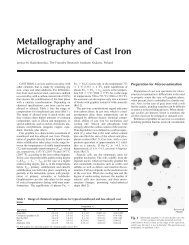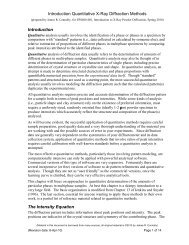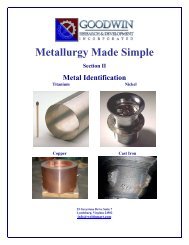ITP Metal Casting: 2002 Metal Casting Industry of the Future ...
ITP Metal Casting: 2002 Metal Casting Industry of the Future ...
ITP Metal Casting: 2002 Metal Casting Industry of the Future ...
Create successful ePaper yourself
Turn your PDF publications into a flip-book with our unique Google optimized e-Paper software.
• Beyond <strong>the</strong> <strong>Metal</strong> <strong>Casting</strong> IOF research funding <strong>of</strong> $23 million received between 1997 and <strong>the</strong><br />
present, EERE has leveraged an additional $19 million on current research and technical<br />
assistance relevant to metal casters. (See page 17)<br />
<strong>2002</strong>- Highlights and Accomplishments<br />
• The metal casting industry is applying <strong>the</strong> results <strong>of</strong> cutting edge IOF research (See pages 21-<br />
24). Examples are listed below.<br />
♦ Steel foundries are making improvements in gating systems, including shrouded<br />
pouring. They are reducing scrap and heat treatment requirements in <strong>the</strong> production<br />
<strong>of</strong> <strong>the</strong>ir castings.<br />
♦ Research has improved yield by 10-25% through development <strong>of</strong> new feeding<br />
distance rules for risering and pressurization <strong>of</strong> risers that reduce shrinkage.<br />
♦ Researchers have developed a ma<strong>the</strong>matical tool that will allow an analytical<br />
approach to systematically design EPS pattern molds that will produce higher quality<br />
patterns with reduced lead-time and expenses.<br />
♦ Researchers have developed cost effective non-incineration techniques that will<br />
significantly reduce VOC emissions from foundries.<br />
♦ Research has led to <strong>the</strong> development <strong>of</strong> modifications <strong>of</strong> die steel chemical<br />
composition and heat processing, resulting in die life improvements <strong>of</strong> 20-30% and<br />
higher.<br />
♦ Researchers have developed a database explaining <strong>the</strong> effects <strong>of</strong> key elements on<br />
<strong>the</strong> properties <strong>of</strong> <strong>the</strong> die cast product, permitting a tailoring <strong>of</strong> alloy components to<br />
optimize die castings for specific applications.<br />
• Through <strong>the</strong> CMC, <strong>the</strong> metal casting industry has updated its long-term vision. The new vision<br />
became <strong>the</strong> basis for <strong>the</strong> new technology roadmap that will be made available in late 2003. (See<br />
page 24).<br />
• EERE BestPractices and Industrial Assessment Centers are providing hands-on technical<br />
assistance that metal casters can apply immediately, saving <strong>the</strong>m millions annually (See page<br />
25).<br />
♦ MetLab in Wyndmoor, Pennsylvania, with assistance from BestPractices, has<br />
developed a plan that will produce an annual savings <strong>of</strong> $528,400. One<br />
recommendation included using proper loading and scheduling, and reevaluating<br />
soak times for heat treating processes for long cycles.<br />
♦ A plant-wide assessment at <strong>the</strong> AMCAST Wapakonet, Ohio plant identified<br />
recommendations that would result in annual savings <strong>of</strong> $3.7 million. As<br />
implementation began AMCAST identified o<strong>the</strong>r cost savings resulting in an annual<br />
savings, <strong>of</strong> $6 million.<br />
ii








